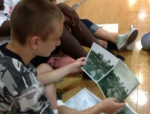Community Embraces New Word Game at Mid-Year Play Day This past Sunday, families at Takoma Park’s Seventh Annual Mid-Year Play Day had the opportunity to experience OtherWordly for the first time. Our educational language game drew curious children and parents to our table throughout the afternoon. Words in Space Several children gathered around our iPads […]
Read moreTag: outreach
 Crowdsourcing can build virtual community, engage the public, and build large knowledge databases about science and culture. But what does it take, and how fast can you grow?
Crowdsourcing can build virtual community, engage the public, and build large knowledge databases about science and culture. But what does it take, and how fast can you grow?
 For some insight, we look at a crowdsourced history site: Historypin is an appealing database of historical photos, with dates, locations, captions, and other metadata. It’s called History “pin” because the photos are pinned on a map. (See recent article about Changes over time, in photos and maps.) Some locations have photos from multiple dates, showing how a place has changed over time, or cross-referenced with Google Maps StreetView. Currently, Historypin has 308k items, from 51k users, and 1.4k institutions. This is a graph of pins over the last three years: (more…)
For some insight, we look at a crowdsourced history site: Historypin is an appealing database of historical photos, with dates, locations, captions, and other metadata. It’s called History “pin” because the photos are pinned on a map. (See recent article about Changes over time, in photos and maps.) Some locations have photos from multiple dates, showing how a place has changed over time, or cross-referenced with Google Maps StreetView. Currently, Historypin has 308k items, from 51k users, and 1.4k institutions. This is a graph of pins over the last three years: (more…)
 Crowdsourcing means involving a lot of people in small pieces of a project. In educational and nonprofit outreach, crowdsourcing is a form of engagement, such as participating in an online course, collecting photos of butterflies for a citizen-science project, uploading old photos for a community history project, deciphering sentences from old scanned manuscripts, playing protein folding games to help scientists discover new ways to fight diseases, or participating in online discussions. (more…)
Crowdsourcing means involving a lot of people in small pieces of a project. In educational and nonprofit outreach, crowdsourcing is a form of engagement, such as participating in an online course, collecting photos of butterflies for a citizen-science project, uploading old photos for a community history project, deciphering sentences from old scanned manuscripts, playing protein folding games to help scientists discover new ways to fight diseases, or participating in online discussions. (more…)
 Sciences and history can nicely meet at historical sites. It engages the history-minded in science, and the science-minded in history. Two examples were recently discussed by Chris Shires, director of interpretation and programs at the Edsel & Eleanor Ford House. (more…)
Sciences and history can nicely meet at historical sites. It engages the history-minded in science, and the science-minded in history. Two examples were recently discussed by Chris Shires, director of interpretation and programs at the Edsel & Eleanor Ford House. (more…)
 Film and video can be compelling forms of communication — but using video in science is hard to do well. Science is complex and scientists are groomed throughout their careers to speak in a precise, measured way. Film makers, on the other hand, rarely have a graduate background in science, and they are attuned to storytelling, colorful characters and sound bites. Thus a conflict often rises between filmmakers and scientists, which is colorfully summarized by wildlife filmmaker Chris Palmer: (more…)
Film and video can be compelling forms of communication — but using video in science is hard to do well. Science is complex and scientists are groomed throughout their careers to speak in a precise, measured way. Film makers, on the other hand, rarely have a graduate background in science, and they are attuned to storytelling, colorful characters and sound bites. Thus a conflict often rises between filmmakers and scientists, which is colorfully summarized by wildlife filmmaker Chris Palmer: (more…)
 Expand your outreach capacity with multiple media, multiple languages, new sites and apps, and other features by hiring freelancers. Here’s an overview of marketplaces we’ve successfully used at IDEA.
Expand your outreach capacity with multiple media, multiple languages, new sites and apps, and other features by hiring freelancers. Here’s an overview of marketplaces we’ve successfully used at IDEA.
Translations
In our global world, there’s no excuse for staying limited to English speakers, especially when there’s greater need for education in non-English places. Even if you have multilingual staff, most translations will be better and more cost effective if you outsource. Professional translators are efficient, and skilled at adapting idioms and phrases. They tend to be detail-oriented, soft spoken individuals. (more…)
 Over 30,000 objects are now available for anyone to savor and study online, for free, in impressive high resolution, in Google’s ‘Art Project.” This is 30x expansion from the thousand objects in the first version launched in February 2011. See our prior article, The virtual vs. the real: Giga-resolution in Google Art Project. The project now has 151 partners in 40 countries; in the U.S., the initial four museums has grown to 29 institutions, including the White House and some university art galleries.
Over 30,000 objects are now available for anyone to savor and study online, for free, in impressive high resolution, in Google’s ‘Art Project.” This is 30x expansion from the thousand objects in the first version launched in February 2011. See our prior article, The virtual vs. the real: Giga-resolution in Google Art Project. The project now has 151 partners in 40 countries; in the U.S., the initial four museums has grown to 29 institutions, including the White House and some university art galleries.
See the site: Google Art Project (more…)
 Make sure your investments on web sites, apps or new real-life programs don’t fail by conducting usability and user experience testing.
Make sure your investments on web sites, apps or new real-life programs don’t fail by conducting usability and user experience testing.
“Usability testing differs from focus groups in that it involves the observation of participants as they actually use the product,” said Ian David Moss, a development consultant who works in the Arts. “They key feature of usability testing that makes it different from most other kinds of feedback-gathering methods is that it is based on direct observation rather than self-reporting….So, rather than have people sit around a room and talk about (for example) how they might react to a new feature or what challenges they face in their daily work, you have people sitting in front of a computer and trying to navigate a website’s capabilities while staff members look over their shoulders and take notes.” (more…)

Gameplay has a lot to teach us about motivating participation through joy. ‘Gamification’ is a new term, coined in 2008, for adapting game mechanics into non-game setting — such as building online communities, education and outreach, marketing, or building educational apps. Here are some ideas for how to do it.
 Achievements
Achievements
Badges, trophies and points represent having accomplished something. Since antiquity, people have been honored with medals, crowns and other decorations. Wreaths made of bay laurel were awarded to Greek athletes, and worn by Roman poets (e.g., Ovid, at left). (more…)
 A cheap and effective way to do community outreach is to piggyback or partner with existing events. NASA did this in a subtle and effective way earlier this month at an annual event for LEGO enthusiasts. “BrickFair” drew over 17 thousand people in a August weekend to a conference center near Dulles airport. (more…)
A cheap and effective way to do community outreach is to piggyback or partner with existing events. NASA did this in a subtle and effective way earlier this month at an annual event for LEGO enthusiasts. “BrickFair” drew over 17 thousand people in a August weekend to a conference center near Dulles airport. (more…)

